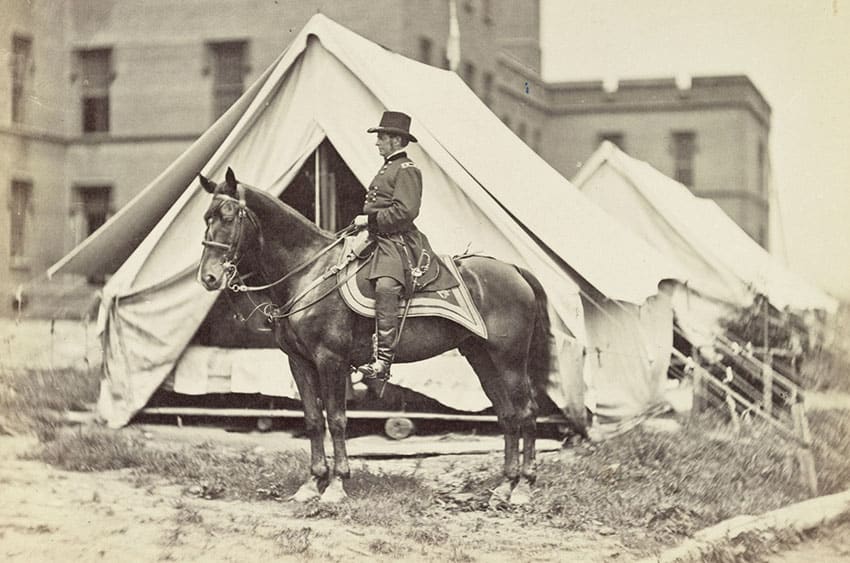
Major General Joseph Hooker took command of the Army of the Potomac on January 26, 1863. He led the Army of the Potomac at Chancellorsville in late April 1863. Photo courtesy of Library of Congress
April 19, 1863 – May 2, 1863
By Phil Kohn
Phil Kohn can be reached at USCW160@yahoo.com
Beginning on April 20, 1863, combined Confederate forces led by Brig. Gens. John Imboden and William “Grumble” Jones conduct several successful raids in western Virginia, capturing over 3,000 head of cattle and 1,200 horses. In Louisiana, Federal troops under Maj. Gen. Nathaniel Banks capture Opelousas, the capital of Confederate Louisiana since Baton Rouge fell in May 1862. (The Confederates once again move the state capital, to Shreveport, in the extreme northwest corner of the state.) In Washington, D.C., President Lincoln announces that West Virginia — which itself had seceded from Virginia — will enter the Union as the nation’s newest state, effective 20 June 1863.
On April 24, Col. Abel Streight’s Union cavalry force disembarks from its transport veessels at Tuscumbia, Alabama, and begins its 160-mile journey toward Rome, Georgia.
In an attempt to relieve the Federal pressure on Vicksburg, Mississippi, Confederate Brig. Gen. John Marmaduke with 5,000 cavalry attacks Fort Girardeau, Missouri, on April 25 hoping to draw Union forces northward. He is unsuccessful at taking the town, however, and soon begins a retreat into Arkansas. On the same day, in Indian Territory, Federal forces from Ft. Gibson attack Col. Stand Watie’s Confederate cavalry at Webber’s Falls, in the Cherokee Nation. The Union troops also disrupt a Confederate Cherokee council meeting at Tahlequah, the capital of the Cherokee Nation.
Maj. Gen. Joseph “Fighting Joe” Hooker begins to move the Army of the Potomac against Gen. Robert E. Lee on April 27. Leaving 30,000 men under Maj. Gen. John Sedgwick at Fredericksburg, Hooker begins marching some 70,000 troops westward along the Rappahannock River with the intent of turning Lee’s left flank. Lee, on his part, has concentrated his forces at Fredericksburg, intending to start his own offensive. Total relative strengths: Hooker, 130,000; Lee, 60,000. (Lee is shorthanded because Lt. Gen. James Longstreet, on a detached-duty mission at Suffolk, Virginia, has two divisions of the First Corps of the Army of Northern Virginia with him.) In Alabama, Brig. Gen. Nathan Bedford Forrest learns of Col. Abel Streight’s Union cavalry heading towards Georgia, and, understanding the implications, sets out in pursuit with 600 Confederate cavalry troopers.
On April 28, Hooker’s main force begins crossing the Rappahannock at a number of fords in an area known as the Wilderness. The troops begin converging on the home and tavern of the Chancellor family — named “Chancellorsville” — located on the main road west from Fredericksburg. There is skirmishing in Fredericksburg.
Gen. Lee begins moving troops westward from Fredericksburg toward Chancellorsville, to meet the threat from the Army of the Potomac. Leaving the division of Maj. Gen. Jubal Early in Fredericksburg to defend against Maj. Gen. John Sedgwick’s VI Corps, Lee moves the First Corps divisions of Maj. Gen. Richard Anderson (on April 29) and Maj. Gen. Lafayette McLaws (on April 30) to positions south of Chancellorsville. Lt. Gen. Thomas “Stonewall” Jackson’s Second Corps of the Army of Northern Virginia also moves out of its position south of Fredericksburg and heads for Chancellorsville.
The final day of April sees much activity. In Virginia, Hooker’s troops settle in, and he sets up his headquarters at Chancellorsville, intending to crush Lee between the two parts of his army — his main force at Chancellorsville and Sedgwick’s VI Corps at Fredericksburg, roughly 10 miles to the east. In Alabama, Forrest’s troopers catch up with Streight’s cavalry at Day’s Gap and Hog Mountain, fighting at each place, and commencing a running cavalry battle across the northern part of the state. (Because of livestock shortages, Streight’s troopers have been equipped with mules. Riding horses, Forrest’s force is faster and more maneuverable.) Farther south, Maj. Gen. U.S. Grant finalizes plans to attack Vicksburg, Mississippi — from the south. He marches his troops down the west bank of the Mississippi to Hard Times, Louisiana, where supplies had been landed, then crosses them to Bruinsburg, Mississippi, on the east bank. Confederates rush reinforcements to Vicksburg from Port Hudson, Louisiana, north of Baton Rouge.
On May 1, Gen. Robert E. Lee — having left 10,000 men under Maj. Gen. Jubal Early at Fredericksburg, Virginia, to face Maj. Gen. John Sedgwick and 40,000 Union troops — joins his 47,000 remaining Confederates, who are camped south of Chancellorsville, some 6 miles west of Fredericksburg. Lee’s intent is to confront Maj. Gen. Joseph Hooker’s 70,000 men who are already at Chancellorsville and strung out in woods of Virginia’s Wilderness to the west. Later that night, Lee and Lt. Gen. Thomas “Stonewall” Jackson devise one of the boldest plans in military history, to be executed by Jackson the next day. In the West, Maj. Gen. Grant’s 40,000 Union troops, having crossed the Mississippi River, begin moving towards Jackson, Mississippi. In Richmond, the Confederate Congress authorizes a new national flag — “The Stainless Banner” — featuring the “Southern Cross” battle flag of the Army of Northern Virginia as the canton on a field of white. It replaces “The Stars and Bars (a circle of white stars on a blue canton on a field of three horizontal stripes, or bars: red-white-red).” The legislators also pass a resolution providing for punishment — including possible execution for inciting insurrection — of white Union officers captured while commanding black Federal troops.
The next day, May 2, Gen. Lee splits his army again, sending Jackson with 26,000 soldiers south, then west, then north to hit Hooker’s unprotected right flank late in the afternoon. The Confederates surprise the Federals (who, having observed Jackson’s men heading south, thought they were retreating), rolling up their line, driving them back toward Chancellorsville until darkness halts the offensive. That evening, Jackson, out scouting, is mistakenly shot by his own pickets upon returning to Confederate lines. With Jackson being evacuated for medical treatment, cavalry commander Maj. Gen. “Jeb” Stuart takes command of Jackson’s troops. In the South, Col. Benjamin Grierson’s Union cavalry ride into Baton Rouge, Louisiana, ending their 16-day raid. Grierson reports over 500 Confederate prisoners taken, 3,000 guns captured or destroyed, and some 50 miles of railroad track damaged, at a cost of three dead, seven wounded and nine missing.







